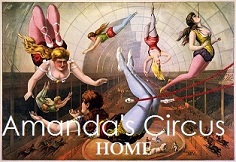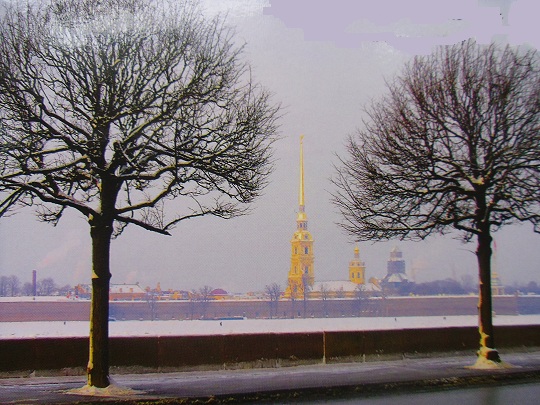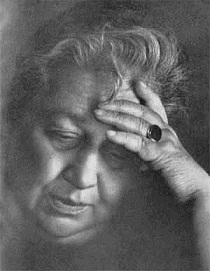St Petersburg – city of stories
I have just returned from chilly St Petersburg with its frozen canals, brilliant sunshine, sudden snowstorms, and the vast Neva River. I’ve always wanted to visit partly because I am fascinated by Russian history but mostly because I’ve always loved Russian literature and music. I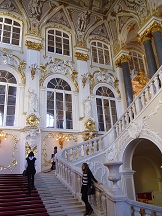 ’m thinking here of Dostoyevsky, Chekov, Tolstoy , Turgenev, Nabokov, Pasternak, Solzhenitsyn, Bulgakov, Shostakovich, Tchaikovsky, Stravinsky, Prokofiev, Mussorgsky, Rimsky-Korsakov, Glinka to name just a random few and I have always been captivated by the difficult story of 20th century Russia.
’m thinking here of Dostoyevsky, Chekov, Tolstoy , Turgenev, Nabokov, Pasternak, Solzhenitsyn, Bulgakov, Shostakovich, Tchaikovsky, Stravinsky, Prokofiev, Mussorgsky, Rimsky-Korsakov, Glinka to name just a random few and I have always been captivated by the difficult story of 20th century Russia.
St Petersburg is a city of palaces, their exteriors painted in salmon pink, powder blue, primrose yellow. Inside, the palaces may be rich, decadently baroque, and full of excess but outside their classical facades have a metronomic rhythm, room to spread, to take up as much space as they need. Nothing is squeezed in and its literary heritage well….
 I also have a handful of personal connections. For example, I own a Russian funeral ring given to me by a great aunt who nursed in the Crimea and which, as a teenager, my piano teacher always asked me to remove because she didn’t like the tarnished silver skull flitting over the keyboard. I once taught the flute to someone, who, when her mother wrote me a cheque I discovered was the daughter of a Russian count. I always thought it was odd that he should have left his country and yet still use his title on his cheques. My third connection is more altruistic. When the Soviet Union was in its death throes, I organised the first holiday for some of the children whose lives were devastated by the Chernobyl disaster. This was a big deal because before that time few ordinary people had been able to travel outside the Soviet Union. My fourth connection comes as a result of the third because I was invited to the Soviet Embassy in London for a reception which, oddly, was decorated by poster portraits of Margaret Thatcher and where we knocked back vodka and salivated on the best beluga caviar. I remember ‘getting lost’ on the way to the loo, seeing a red telephone and wondering if it was a direct line to Premier Rkyzkov. Very James Bond.
I also have a handful of personal connections. For example, I own a Russian funeral ring given to me by a great aunt who nursed in the Crimea and which, as a teenager, my piano teacher always asked me to remove because she didn’t like the tarnished silver skull flitting over the keyboard. I once taught the flute to someone, who, when her mother wrote me a cheque I discovered was the daughter of a Russian count. I always thought it was odd that he should have left his country and yet still use his title on his cheques. My third connection is more altruistic. When the Soviet Union was in its death throes, I organised the first holiday for some of the children whose lives were devastated by the Chernobyl disaster. This was a big deal because before that time few ordinary people had been able to travel outside the Soviet Union. My fourth connection comes as a result of the third because I was invited to the Soviet Embassy in London for a reception which, oddly, was decorated by poster portraits of Margaret Thatcher and where we knocked back vodka and salivated on the best beluga caviar. I remember ‘getting lost’ on the way to the loo, seeing a red telephone and wondering if it was a direct line to Premier Rkyzkov. Very James Bond.
The rest of my interest is literary and musical. Most recently, I have been reading the work of Ludmilla Petrushevskaya and from there I researched Anna Akhmatova and became obsessed with an even greater passion for Russia. I began wondering at the life of this patriotic woman who remained in Russia (mostly St. Petersburg) from the time of the Russian Civil War, throughout the purges of the Stalinist regime, even though so many of her friends emigrated, even though her work was banned and her husband arrested and sentenced to hard labour, eventually dying in jail, and even though her son was executed by the regime. So the upshot was, I bought a thick goosedown coat and some tall boots, managed to get a visa, packed my woolly socks and took my sixteen year old daughter, Lil, with me to St Petersburg.
St Petersburg has to be the city of inspiration for the short story writer. Since the time of Pushkin at the beginning of the 19th century, so many of the great Russian writers lived, worked and set their stories here. And the Russians have always written and read short stories and held them in equal if not greater respect than the novel. All the great Russian writers wrote short stories and many solely wrote short stories.
Just a few doors 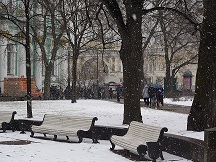 from our hotel on Malaya Morskaya lived Gogol, across the road lived Tchaikovsky and a little further up on the same road was the house in which lived Pushkin’s fictional elderly Countess of the ‘Queen of Spades’ fame and about which Tchaikovsky wrote an opera. How interesting is that connection! Tchaikovsky’s apartment was just across the road from the countess’ house. He would have seen it from his window. So, from the moment I stepped into the brilliant sunshine and bone-cracking chill, I was living stories and feeling the past all around.
from our hotel on Malaya Morskaya lived Gogol, across the road lived Tchaikovsky and a little further up on the same road was the house in which lived Pushkin’s fictional elderly Countess of the ‘Queen of Spades’ fame and about which Tchaikovsky wrote an opera. How interesting is that connection! Tchaikovsky’s apartment was just across the road from the countess’ house. He would have seen it from his window. So, from the moment I stepped into the brilliant sunshine and bone-cracking chill, I was living stories and feeling the past all around.
You can walk the route that Gogol’s Akaky Akakievich took to work, wander round the square where the thief stole his precious greatcoat. You can walk along Nevsky Prospekt, the main shopping avenue, where Dostoyevsky met friends in the Wolf Coffeehouse and the Writers’ Bookshop, and where so many of the avant-garde literati met up in the 1920s to drink, read, talk and fall in love. Across Nevsky is the Alexandrinsky Theatre where Chekov’s play ‘The Seagull’ bombed on its first night. Danil Kharms’ story, ‘The Old Woman’ is a St Petersburg story as much as ‘The Greatcoat’, ‘The Queen of Spades’ and much of the work of Dostoyevsky. You can walk from St Isaac’s cathedral past Nabokov’s apartment, to the Mariinsky Theatre, home of the Kirov, and opposite is the Rimsky-Korsakov Conservatoire, all those great composers walked these streets to study or teach there. A few further blocks, we walked to the corner of Sadovaya Street as did Kharms’ character before he found the old woman dead in his apartment.
There is a great deal written about these old women and I’m not surprised. In every room in every museum or palace you will find an old woman, sometimes she will be reading, or writing or nodding off. They are often elegantly made-up and well-dressed; they are always delighted to chat with you or gossip about you with each other, trying to guess how the pair of you are related or where you come from, sometimes they actually come over and ask, such is their nosiness (have no doubt, I can sympathise with that). But they are working in their hundreds here. And when their shift is up, they dash off to their break at warp speed, we know because once we tried to follow them into their section of the Hermitage. No luck. They are also the conductresses on the trolley buses and beg wrapped in shawls in the poorer streets. I think that, since the new regime, families have been given their own apartments, this means that often there are many people living in a small place and no one is moving because they all own it, and we can all sympathise with the problems of property. I think the pension is very small, prices are rising and that there are now fewer automatic benefits for the elderly. This may be the reason that so many are working well in their seventies.
 As for Dostoyevsky, it would take a week to visit all the apartments in which he lived, let alone those of his characters. Dostoyevsky has been considered one of the greatest Russian writers by the west but his reputation in Russia was denigrated. None of his descendants receive any royalties from the millions of his books that must have sold over the years. The Dostoevsky Museum (his final apartment) is in a slightly seedy area near Kuznechniy market, an indoor market. Outside old men and old women sell a few home-grown beetroot, bunches of pussy willow, a handful of parsley, a single jar of home-pickled gherkins or a few eggs all of different colours. I watched a very old lady, on the arm of her daughter, put a few roubles in the tin of an injured soldier. The daughter looked disapproving. I wondered what this old woman had been through. She was in her eighties or nineties, perhaps as a child she saw the Civil War, she undoubtedly witnessed the Siege, endured life under Stalin, the repressive Soviet system and then the breakup of the Soviet Union and now the rampant consumerism and, for many, hopeless poverty. As a young man Dostoyevsky was inspired by the French Revolution and became part of a socialist group who met every Friday to discuss their ideas. Tsar Nicholas I became uneasy and had the Petrashevsky Circle arrested. Dostoyevsky, aged 27, was imprisoned in the Peter and Paul Fortress, his crime: for reading aloud and for having the desire to circulate a letter from Belinsky to Gogol. Tsar Nicholas I decided to make an example of them. On the morning of December 22nd 1849 the prisoners were taken to Semyonovsky Square and, to the roll of a drum, the sentence was read, ‘death by firing squad’. The priest gave last sacraments, the prisoners were tied to poles and bags put over their heads. At the last minute, the sentence was revoked to hard labour and life in the army. What a terrible experience! Dostoyevsky described a similar moment, possibly the actual incident in the words of Prince Myshkin in ‘The Idiot’:
As for Dostoyevsky, it would take a week to visit all the apartments in which he lived, let alone those of his characters. Dostoyevsky has been considered one of the greatest Russian writers by the west but his reputation in Russia was denigrated. None of his descendants receive any royalties from the millions of his books that must have sold over the years. The Dostoevsky Museum (his final apartment) is in a slightly seedy area near Kuznechniy market, an indoor market. Outside old men and old women sell a few home-grown beetroot, bunches of pussy willow, a handful of parsley, a single jar of home-pickled gherkins or a few eggs all of different colours. I watched a very old lady, on the arm of her daughter, put a few roubles in the tin of an injured soldier. The daughter looked disapproving. I wondered what this old woman had been through. She was in her eighties or nineties, perhaps as a child she saw the Civil War, she undoubtedly witnessed the Siege, endured life under Stalin, the repressive Soviet system and then the breakup of the Soviet Union and now the rampant consumerism and, for many, hopeless poverty. As a young man Dostoyevsky was inspired by the French Revolution and became part of a socialist group who met every Friday to discuss their ideas. Tsar Nicholas I became uneasy and had the Petrashevsky Circle arrested. Dostoyevsky, aged 27, was imprisoned in the Peter and Paul Fortress, his crime: for reading aloud and for having the desire to circulate a letter from Belinsky to Gogol. Tsar Nicholas I decided to make an example of them. On the morning of December 22nd 1849 the prisoners were taken to Semyonovsky Square and, to the roll of a drum, the sentence was read, ‘death by firing squad’. The priest gave last sacraments, the prisoners were tied to poles and bags put over their heads. At the last minute, the sentence was revoked to hard labour and life in the army. What a terrible experience! Dostoyevsky described a similar moment, possibly the actual incident in the words of Prince Myshkin in ‘The Idiot’:
‘So there were five minutes left to live, no more. He said that these five minutes seemed to him like an endless period, an enormous wealth of time… A church stood not far away, and the top of the cathedral with its gilded roof twinkled in the bright sun. He remembered he looked at that roof and the rays twinkling from it with an awful persistence; he could not tear himself away from those rays. It seemed to him that the rays were his new nature, that he would somehow flow into them in three minutes’ time.’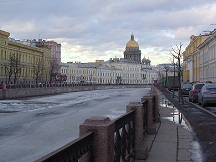
And that cathedral, St Isaacs, with its golden dome was just at the end of our road.
Dostoyevsky told his brother that from that moment he realised that life is within us, not something external in the outside world. He was sent to Siberia in leg irons and forbidden to read or write. Eventually he was moved into the army and finally managed to get out due to ill health. But in prison Dostoyevsky learned a great deal about humanity. He wrote: ‘How many stories of tramps and thieves…What wonderful people…my time was not wasted’
In 1865, Dostoyevsky began ‘Crime and Punishment’. The story of the poor student, Raskolnikov, who decides to kill an evil greedy old woman, a money lender, and rob her. He plans to make his mother happy, rescue his sister from the clutches of a lustful master, and to travel and continue his studies generally planning to smooth out the crime by living a good life thereby paying back his debt to mankind.
At 19 Grazhdanskaya Street is the house in the novel where fictional Raskolnikov may have lived, now complete with plaque and monument. It’s interesting to discover that Dostoyevsky’s handwritten manuscripts are splattered with rough sketches of his characters with mysterious expressions and illustrations of buildings.
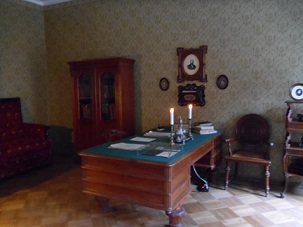 Dostoyevsky took over his brother’s debts on his death and became an inherent gambler. He was forced to write on commission and often signed contracts hastily. He got himself into the position that he had to write a novel in one month. If he were to fail, according to his contract, he would lose all rights and royalties to all his future works. It seemed impossible but friends urged him to try and suggested he hire a stenographer. So he hired Anna Snitkina who he described as ‘a fairly attractive woman’. With her help he wrote ‘The Gambler’ in twenty-six days and then proposed to her. She was twenty he was forty. It wa
Dostoyevsky took over his brother’s debts on his death and became an inherent gambler. He was forced to write on commission and often signed contracts hastily. He got himself into the position that he had to write a novel in one month. If he were to fail, according to his contract, he would lose all rights and royalties to all his future works. It seemed impossible but friends urged him to try and suggested he hire a stenographer. So he hired Anna Snitkina who he described as ‘a fairly attractive woman’. With her help he wrote ‘The Gambler’ in twenty-six days and then proposed to her. She was twenty he was forty. It wa s a good move for Dostoyevsky. She organised his writing life and his finances from then on; she even sold his novels and distributed his books by subscription. She had a great deal to put up with, he gambled his way across Europe and they spent much of their time explaining why they couldn’t pay the rent and living in acute hardship. Finally they moved to the rather pleasant apartment in which the Dostoyevsky museum is now housed and in which you can see his hat under a glass dome, also his desk, the view at which he stared as he wrote ‘The Brothers Karamazov’, his tea drinking apparatus. And it is here where his beloved son died and also eventually Dostoyevsky himself from emphysema, he smoked a great deal.
s a good move for Dostoyevsky. She organised his writing life and his finances from then on; she even sold his novels and distributed his books by subscription. She had a great deal to put up with, he gambled his way across Europe and they spent much of their time explaining why they couldn’t pay the rent and living in acute hardship. Finally they moved to the rather pleasant apartment in which the Dostoyevsky museum is now housed and in which you can see his hat under a glass dome, also his desk, the view at which he stared as he wrote ‘The Brothers Karamazov’, his tea drinking apparatus. And it is here where his beloved son died and also eventually Dostoyevsky himself from emphysema, he smoked a great deal.
The Anna Akh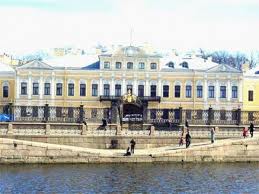 matova museum is in servant’s wing of the Sheremetev Palace, right at the back. This is not as easy as you might think and takes a bit of finding. The palace is on the Fontanka and now houses the National Collection of Musical Instruments. In my experience National Collections of Musical Instruments never amount to much, just a few well-used battered or freakishly over-ornate instruments. But still, since we’d found it, we thought we might as well take a look. The main rooms are beautifully decorated and very interesting, if you’re into pianos and stringed instruments. Someone was rehearsing Rachmaninov. Amazing piano playing behind a closed door, guarded by an old lady who refused to let us in which was fair enough but no harm in asking. It also housed the G
matova museum is in servant’s wing of the Sheremetev Palace, right at the back. This is not as easy as you might think and takes a bit of finding. The palace is on the Fontanka and now houses the National Collection of Musical Instruments. In my experience National Collections of Musical Instruments never amount to much, just a few well-used battered or freakishly over-ornate instruments. But still, since we’d found it, we thought we might as well take a look. The main rooms are beautifully decorated and very interesting, if you’re into pianos and stringed instruments. Someone was rehearsing Rachmaninov. Amazing piano playing behind a closed door, guarded by an old lady who refused to let us in which was fair enough but no harm in asking. It also housed the G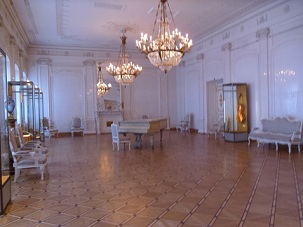 linka museum with his desk, pen, manuscripts and suitcase and lots of old programmes, cuttings and photographs. Downstairs in a sort of storeroom are the wind and percussion. It comprises a collection of single note horns that make a horn orchestra, the mind boggles at how that works. There was also a fair collection of flutes and bassoons, all housed in dusty cabinets. Again, guarded by a troupe of old ladies who seemed especially enthusiastic, possibly because they are stuck downstairs in a windowless room, surrounded by dusty white-painted brick walls and many old radiator pipes. Perhaps that’s why the wind section is relegated to down here in a dark, damp old storeroom.
linka museum with his desk, pen, manuscripts and suitcase and lots of old programmes, cuttings and photographs. Downstairs in a sort of storeroom are the wind and percussion. It comprises a collection of single note horns that make a horn orchestra, the mind boggles at how that works. There was also a fair collection of flutes and bassoons, all housed in dusty cabinets. Again, guarded by a troupe of old ladies who seemed especially enthusiastic, possibly because they are stuck downstairs in a windowless room, surrounded by dusty white-painted brick walls and many old radiator pipes. Perhaps that’s why the wind section is relegated to down here in a dark, damp old storeroom.
Anyway, we had to really lo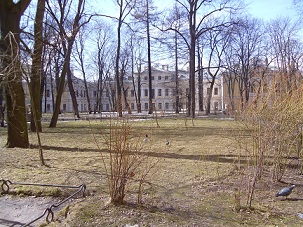 ok hard to find the Anna Akhmatova Museum. It involved a long walk around the block, through a dingy passageway and then through a muddy garden. This was the Fountain House. Not a fountain to be seen. We bought tickets and tried to find the way in. Inside these buildings in St Petersburg it is always very hot so the first thing you need to do is offload your coat. There is always a cloakroom, so we located this and then obviously took a wrong turn. We found ourselves in a gallery where an artist was setting up an exhibition, guarded by a tall, glamorous old lady who spoke German and sent us upstairs. We found ourselves con
ok hard to find the Anna Akhmatova Museum. It involved a long walk around the block, through a dingy passageway and then through a muddy garden. This was the Fountain House. Not a fountain to be seen. We bought tickets and tried to find the way in. Inside these buildings in St Petersburg it is always very hot so the first thing you need to do is offload your coat. There is always a cloakroom, so we located this and then obviously took a wrong turn. We found ourselves in a gallery where an artist was setting up an exhibition, guarded by a tall, glamorous old lady who spoke German and sent us upstairs. We found ourselves con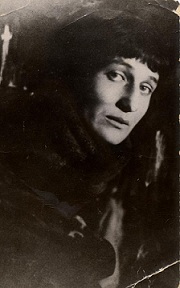 fronted by a closed door. We knocked. No answer. We opened the door slowly, peering round to find another old lady, a very serious small woman dressed in grey and locked into her ipod. We gave her a shock, no doubt about that. She was nice but very insistent that we take an audio guide, very insistent indeed and refused to take any money for it. She also insisted that we turned round and went back the way we came and closed the door on us.
fronted by a closed door. We knocked. No answer. We opened the door slowly, peering round to find another old lady, a very serious small woman dressed in grey and locked into her ipod. We gave her a shock, no doubt about that. She was nice but very insistent that we take an audio guide, very insistent indeed and refused to take any money for it. She also insisted that we turned round and went back the way we came and closed the door on us.  We were confused. We returned to the gallery where the glamorous old lady set off the audio guide and had us listening on the stairs and then left us to it. Once we had the audio guide and knew what the whole thing was about, and only then, the serious old lady let us in. It was the beginning of an amazing journey.
We were confused. We returned to the gallery where the glamorous old lady set off the audio guide and had us listening on the stairs and then left us to it. Once we had the audio guide and knew what the whole thing was about, and only then, the serious old lady let us in. It was the beginning of an amazing journey.
It is one of the most wonderful places I have been. The apartment is in the servants’ wing and Akhmatova lived here for most of her adult life, beginning in 1918 with her second marriage, to Shileiko. Fluent in forty languages and translator of ancient Assyrian texts, Shileiko had been tutor to the grandchildren of the Sheremetevs. After their divorce, Akhmatova continued to live there as the common-law wife of art historian, Nikolay Nikolayevich Punin (at the same time as his wife). The choice to stay in Russia after the Revolution in 1918 was to define Akhmatova’s whole life. She wrote, ‘My shadow is on your wall’ and although a glamorous seductress, I think she saw herself as a shadow, never really materialising, perhaps affecting people with her darkness. Her first husband, Gumilov was arrested  and shot, and her circle of friends became diminished because of illness, repression and emigration. Initially, in Tsarist Russia her work had been published and respected but increasingly she and her friends became disillusioned with the Soviet order and their work was repressed. In 1940 Akhmatova began to write ‘Poem without a Hero’ which can be read here http://www.donmager.org/PWH4Versions.pdf
and shot, and her circle of friends became diminished because of illness, repression and emigration. Initially, in Tsarist Russia her work had been published and respected but increasingly she and her friends became disillusioned with the Soviet order and their work was repressed. In 1940 Akhmatova began to write ‘Poem without a Hero’ which can be read here http://www.donmager.org/PWH4Versions.pdf
and continued to do so in secet throughout her time at the Fountain House. When Punin was arrested and sent to Siberia he wrote: ‘The essential thing is not to lose despair’. I think that’s very telling. Perhaps he’s cautioning her, don’t convince yourself that it’s right to fall in line, you need to see the worst and feel it if you are to understand the truth. Influenced by the Cubists, he later wrote how he was attempting: ’to see the world as from an angel, from different sides and from within.’
In the apartment you c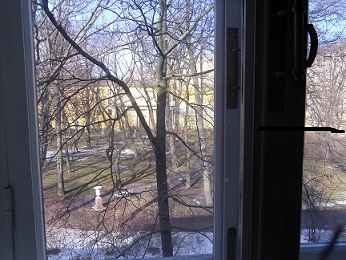 an see the corridor in which her son, Lev Gumilov, lived. After Akhmatova met with British philosopher, Isiah Berlin, she was accused of spying. Her son, Lev, was repeatedly arrested, tortured and finally murdered. And you wonder whether Akhmatova had to chose between her son and poetry, whether she saw it in that way or not. I don’t believe she did. In her effort to save her son, in 1950 Akhmatova published poems in praise of Stalin. Stalin never imprisoned Akhmatova, he had been told she was a ‘great’ poet. Perhaps he was afraid of this ‘greatness’, perhaps he knew that taking away all of those close to her was the greatest torture of all. From the window you can see the garden where she watched the KGB agents watch her when she was under house arrest. In the tiny hallway,
an see the corridor in which her son, Lev Gumilov, lived. After Akhmatova met with British philosopher, Isiah Berlin, she was accused of spying. Her son, Lev, was repeatedly arrested, tortured and finally murdered. And you wonder whether Akhmatova had to chose between her son and poetry, whether she saw it in that way or not. I don’t believe she did. In her effort to save her son, in 1950 Akhmatova published poems in praise of Stalin. Stalin never imprisoned Akhmatova, he had been told she was a ‘great’ poet. Perhaps he was afraid of this ‘greatness’, perhaps he knew that taking away all of those close to her was the greatest torture of all. From the window you can see the garden where she watched the KGB agents watch her when she was under house arrest. In the tiny hallway, hangs Punin’s overcoat, a poignant reminder but in fact he had left for good. He was taken from the apartment, imprisoned, tortured and finally died before he could return. Perhaps it’s true that Akhmatova is iconic for what she had not been allowed to do rather than for her achievements but this apartment is an affecting memorial to repression.
hangs Punin’s overcoat, a poignant reminder but in fact he had left for good. He was taken from the apartment, imprisoned, tortured and finally died before he could return. Perhaps it’s true that Akhmatova is iconic for what she had not been allowed to do rather than for her achievements but this apartment is an affecting memorial to repression.
Akhmatova died in 1966 in a sanatorium outside Moscow and her body was brought back to St Petersburg. She has been recognised as Russia’s foremost 20th century poet and her work, most famously ‘Requiem’ written from 1935-1940, is now published in Russia. ‘Requiem’ can be read in full here: http://www.poetryloverspage.com/poets/akhmatova/requiem.html
A monument t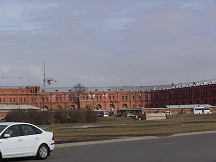 o mark the 40th anniversary of her death was erected across the Neva River from the notorious Kresty holding prison where she queued for days in the snow waiting for news of Lev during his numerous imprisonments throughout the Stalinist terror. The inscription comes from ‘Requiem’ written in secret during the purges. It reads:
o mark the 40th anniversary of her death was erected across the Neva River from the notorious Kresty holding prison where she queued for days in the snow waiting for news of Lev during his numerous imprisonments throughout the Stalinist terror. The inscription comes from ‘Requiem’ written in secret during the purges. It reads:
‘That’s why I pray not for myself,
But for all of you who stood there with me,
Through fiercest cold and scorching July heat,
Under a towering, completely blind red wall.’
We vis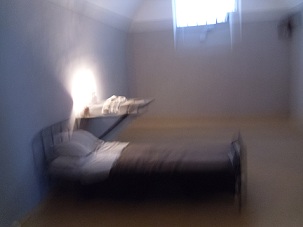 ited the Peter and Paul Fortress and the Kresty prison where so many people had been imprisoned including Dostoyevsky and Lev Gumilov. It is a chilling place, many committed suicide here. The inmates were not allowed to communicate in any way but developed their own tapping alphabet. Hessian mats were laid along the corridors to soften the footsteps of the guards so that they could creep up and observe prisoners without them suspecting.
ited the Peter and Paul Fortress and the Kresty prison where so many people had been imprisoned including Dostoyevsky and Lev Gumilov. It is a chilling place, many committed suicide here. The inmates were not allowed to communicate in any way but developed their own tapping alphabet. Hessian mats were laid along the corridors to soften the footsteps of the guards so that they could creep up and observe prisoners without them suspecting.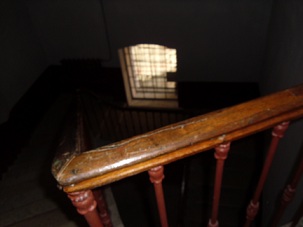
St Petersburg is a city of sky and water and tragedy. It is a city of space and to wander through its streets, palaces and museums and especially to tread the staircases trodden by Dostoyevsky, Akhmatova and the prisoners, even the Romanovs is something so direct and unforgettable. If you go, or even if you don’t, read the Penguin Classics ‘Russian Short Stories from Pushkin to Buida’ edited by Robert Chandler for a fascinating overview of two hundred years of Russian literature.
 Anna Akhmatova Museum: http://en.akhmatova.spb.ru/start.56.html
Anna Akhmatova Museum: http://en.akhmatova.spb.ru/start.56.html
Dostoevsky Apartment: http://www.md.spb.ru/
